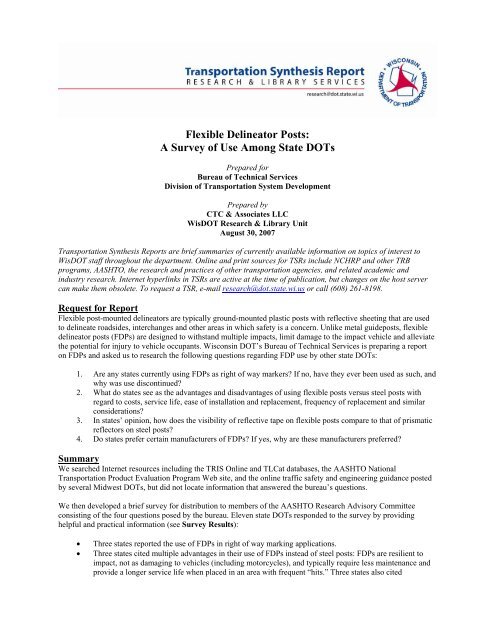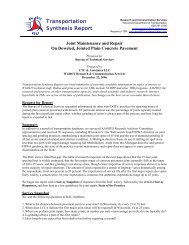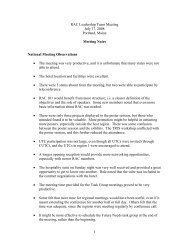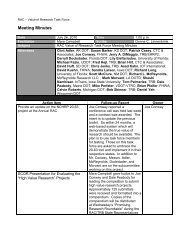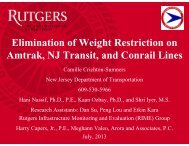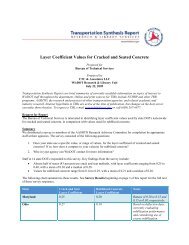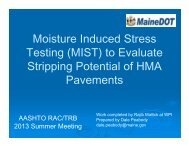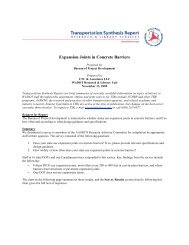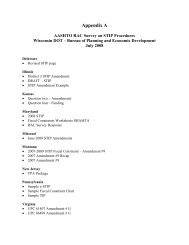Flexible Delineator Posts - WisDOT Research
Flexible Delineator Posts - WisDOT Research
Flexible Delineator Posts - WisDOT Research
Create successful ePaper yourself
Turn your PDF publications into a flip-book with our unique Google optimized e-Paper software.
<strong>Flexible</strong> <strong>Delineator</strong> <strong>Posts</strong>:A Survey of Use Among State DOTsPrepared forBureau of Technical ServicesDivision of Transportation System DevelopmentPrepared byCTC & Associates LLC<strong>WisDOT</strong> <strong>Research</strong> & Library UnitAugust 30, 2007Transportation Synthesis Reports are brief summaries of currently available information on topics of interest to<strong>WisDOT</strong> staff throughout the department. Online and print sources for TSRs include NCHRP and other TRBprograms, AASHTO, the research and practices of other transportation agencies, and related academic andindustry research. Internet hyperlinks in TSRs are active at the time of publication, but changes on the host servercan make them obsolete. To request a TSR, e-mail research@dot.state.wi.us or call (608) 261-8198.Request for Report<strong>Flexible</strong> post-mounted delineators are typically ground-mounted plastic posts with reflective sheeting that are usedto delineate roadsides, interchanges and other areas in which safety is a concern. Unlike metal guideposts, flexibledelineator posts (FDPs) are designed to withstand multiple impacts, limit damage to the impact vehicle and alleviatethe potential for injury to vehicle occupants. Wisconsin DOT’s Bureau of Technical Services is preparing a reporton FDPs and asked us to research the following questions regarding FDP use by other state DOTs:1. Are any states currently using FDPs as right of way markers? If no, have they ever been used as such, andwhy was use discontinued?2. What do states see as the advantages and disadvantages of using flexible posts versus steel posts withregard to costs, service life, ease of installation and replacement, frequency of replacement and similarconsiderations?3. In states’ opinion, how does the visibility of reflective tape on flexible posts compare to that of prismaticreflectors on steel posts?4. Do states prefer certain manufacturers of FDPs? If yes, why are these manufacturers preferred?SummaryWe searched Internet resources including the TRIS Online and TLCat databases, the AASHTO NationalTransportation Product Evaluation Program Web site, and the online traffic safety and engineering guidance postedby several Midwest DOTs, but did not locate information that answered the bureau’s questions.We then developed a brief survey for distribution to members of the AASHTO <strong>Research</strong> Advisory Committeeconsisting of the four questions posed by the bureau. Eleven state DOTs responded to the survey by providinghelpful and practical information (see Survey Results):• Three states reported the use of FDPs in right of way marking applications.• Three states cited multiple advantages in their use of FDPs instead of steel posts: FDPs are resilient toimpact, not as damaging to vehicles (including motorcycles), and typically require less maintenance andprovide a longer service life when placed in an area with frequent “hits.” Three states also cited
disadvantages in their use of FDPs: higher purchase cost as well as susceptibility to destruction byroadside mowers and plowed snow.• Several states reported that reflective tape or sheeting provides visibility that is comparable to or betterthan prismatic reflectors.• Three states purchase FDPs from Safe-Hit, while two states purchase from Carsonite Composites LLC.One state, a Safe-Hit customer, provided reasons for choosing that manufacturer (cost, breakaway designand ease of replacement). One state also purchases from two additional manufacturers: FlexStakeIncorporated and Three D Traffic Works.Survey responses received after Aug. 27, 2007, will be forwarded directly to the bureau.Survey ResultsArkansasRespondent: Tony Sullivan, Assistant State Maintenance Engineer, Arkansas Highway and TransportationDepartment, (501) 569-2661, Tony.Sullivan@arkansashighways.com.1. We do not use flexible delineator posts as right of way markers. We sometimes use them to separate lanes or tochannelize traffic at an intersection where u-channel, steel-post-mounted delineators may get hit often.2. [No response indicated.]3. The visibility of the reflective tape is comparable to prismatic sheeting on aluminum reflectors.4. We mostly use Safe-Hit posts. See www.safehitlx.com.IdahoRespondent: Steve Holland, Transportation Staff Engineer Assistant, Office of Highway Operations and Safety,(208) 334-8565, Steve.Holland@itd.idaho.gov.1. No, but flexible posts have been used as witness posts to mark a location of the RW marker. The IdahoTransportation Department has always used an RW monument, which consists of a concrete cone with a brassmarker embedded in the top. See Standard Drawing I-2-A at www.itd.idaho.gov/design/StandardDrawings.htm.2. Not applicable.3. A few years back, the Idaho Transportation Department changed from using prismatic reflector buttons on steeldelineator posts to sheeted aluminum reflectors on steel delineator posts or the option of retro-reflective sheetingapplied directly to flexible posts. This was due to the fact that the prismatic reflectors were constantly being brokenby snowplowing or chip seal rock being thrown by passing vehicles. We have had no problems with the sheetingapplied to aluminum as reflectors, and they appear to work as well for visibility. The flexible-post styles work verywell also, but are a second choice as the majority of our originals have steel posts so the delineator is the only partthat gets replaced. Also, the maintenance crews have problems driving the flexible posts due to many locationshaving basalt or large river rock below the top soil surface. The steel posts can be more readily driven and can bedrilled in also. We did, however, have some projects that installed the flexible posts and so a replacement in kind isthe policy. See our Standard Drawing G-3-A at www.itd.idaho.gov/design/StandardDrawings.htm.4. The Idaho Transportation Department has not developed a preference for a particular manufacturer of the flexiblepost, but in fact has developed a listing on our Qualified Products List that shows several available for use.However, as I previously stated, the majority are the steel-post style.IowaRespondent: Deanna Maifield, Methods Engineer, Office of Design, (515) 239-1402,Deanna.Maifield@dot.iowa.gov.Iowa DOT doesn’t use flexible delineator posts. To my knowledge, the subject has never been discussed.MissouriRespondent: Jim Brocksmith, Technical Support Engineer, (573) 751-1097, Jim.Brocksmith@modot.mo.gov.1. I assume you mean as delineators and not right of way markers. We installed flexible delineators on our system inthe early 1990s. We have since discontinued their use and are now installing channel-post delineators. We stoppedusing the flexible posts since our field people were not maintaining them. When they would get hit by vehicles ormowers, they were not being replaced and looked bad.2. The flexible posts are a good item, but like anything, they need to be maintained. They did bounce back after thefirst few hits but eventually they failed. We also had a lot of instances where our mowers cut them down as theydrove over them. The mowers are less likely to drive over the steel channel posts, but they haven’t proven to be aseasy to straighten as we thought.2
3. We do not use hard prismatic reflectors on our steel channel posts. We essentially make a small sign withdiamond-grade-type sheeting that is used on the posts.4. When we were using flexible posts, we had standardized on one brand for consistency and repair parts.MontanaRespondent: Jim Cornell, Traffic – Signing, (406) 444-6222, jicornell@mt.gov.1. I am not aware that MDT uses flexible delineator posts for right of way markers.2. Cost of flexible delineators is about three times more than steel posts.3. MDT uses retro-reflective high-intensity sheeting on both.4. Not that I’m aware of. The district maintenance supervisor would probably be able to tell you where they get theirflexible delineators or who they prefer.OregonRespondent: Katie Johnson, Traffic – Roadway Section, (503) 986-3610, Katryn.L.JOHNSON@odot.state.or.us.1. Yes, ODOT currently does use flexible delineator posts to mark right of way monuments. Steel posts are also anoption. ODOT’s Right of Way Monumentation Policy is athwww.oregon.gov/ODOT/HWY/GEOMETRONICS/docs/ODOT_RW_Monumentation_Policy.pdf.For the purpose of delineation of the roadway, we also use flexible as well as steel. Here is a link to our trafficdrawings for pavement marking:hwww.oregon.gov/ODOT/HWY/ENGSERVICES/traffic_drawings.shtml#Traffic_500___Pavement_Marking.<strong>Delineator</strong> details are in drawings TM570, TM571, TM575, TM576 and TM577.2. Main advantage of flexible markers: typically less maintenance and greater service life when placed in an areawith frequent “hits.” There isn’t a significant cost difference between the steel and flexible, according to our averagebid item prices for 2006. Steel delineators are mainly used in snow zone areas. (<strong>Flexible</strong> delineators can’t withstandthe force of snow-plowed snow.)3. ODOT currently only specifies using reflective sheeting (ASTM type III or IV) on delineators, regardless ofwhether the post is steel or flexible. I don’t have the history on why this decision was made, but I assume ODOTfound the reflective sheeting to perform better than prismatic reflectors. Retro-reflective sheeting is not used to markright of way monuments.4. All delineator posts used on ODOT right of way have to come from the Qualified Products List. See pages 138and 139 of the PDF: www.oregon.gov/ODOT/HWY/CONSTRUCTION/QPL/Docs/QPL.pdf. The delineator specnumbers are 02850.10 for steel posts and 02850.30 for flexible posts. As you can see, there are several differentmanufacturers we allow on ODOT projects for flexible delineators. For the vendor requirements to get onto theQualified Products List for flexible delineators, seewww.oregon.gov/ODOT/HWY/CONSTRUCTION/QPL/Docs/<strong>Delineator</strong>s<strong>Flexible</strong>.pdf.PennsylvaniaRespondent: Ken Williams, Bureau of Highway Safety and Traffic Engineering, (717) 787-3620,kennwillia@state.pa.us. (Ken responded to questions 3 and 4. Responses to questions 1 and 2 were said to beforthcoming from other staff, but were not received by time of publication.)3. PennDOT prefers the tape because of the variations in size and the option of color coordinating the post with thesheeting. The prismatic reflectors may provide delineation further down the road, but the tape is reflective enough toguide motorists at highway speeds. Durability of the prismatic reflectors is greater than the tape. We do not like steelposts because they are not flexible and motorcycle-friendly.4. PennDOT prefers Safe-Hit flexible delineator posts because of cost, breakaway design and ease of replacement.Here is the contact information: Steve Draginis, 577 Chestnut Court, Wauconda, IL 60084, (847) 526-0561 (office),(847) 526-0565 (fax), 800-255-3240, ext. 8432 (toll-free voicemail), 312-805-8422 (mobile). Territory: Iowa,Kansas, Minnesota, North Dakota, Nebraska, South Dakota and Wisconsin.South CarolinaRespondent: Terry Rawls, Traffic Services Manager, (803) 737-1498, rawlstl@scdot.org.1. Yes.2. <strong>Flexible</strong> posts can be hit and will normally return to an upright position and still function. Sometimes they maycost more, but they will provide a longer service life if in an area where they are hit often. They will not damagevehicles like metal posts.3. With the new sheeting types, the visibility may be better.4. We do not prefer a certain manufacturer, but some posts perform better than others.3
WashingtonRespondent: Ed Lagergren, Traffic Design Standards and Materials Manager, WSDOT Traffic Operations Office,(360) 705-7284, LagergE@wsdot.wa.gov.1. No, they are used in accordance with the MUTCD.2. <strong>Flexible</strong> posts are easy to install, rebound when hit, are not a roadside hazard and have a longer service life. (Steelposts last until the first hit.)3. Don’t know.4. Our maintenance crews prefer Carsonite. See www.carsonite.com/home.asp.West VirginiaRespondent: Harry Bergstrom, Division of Highways, (304) 558-7424, hbergstrom@dot.state.wv.us.1. West Virginia DOT uses 3/8-inch rebar and plastic cap as right of way markers. Previously, 4x4 concrete markerswere used. WVDOT has never used delineator posts for this purpose.2. Not applicable.3. Not applicable.4. Not applicable.WyomingRespondent: Michael Patritch, <strong>Research</strong> Manager, WYDOT <strong>Research</strong> Center, (307) 777-4182,michael.patritch@dot.state.wy.us.1. WYDOT uses flexible posts because of the wind.2. Not applicable.3. Not applicable.4. Not applicable.4


